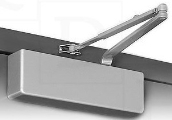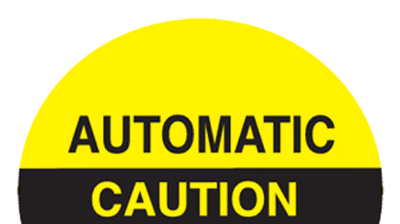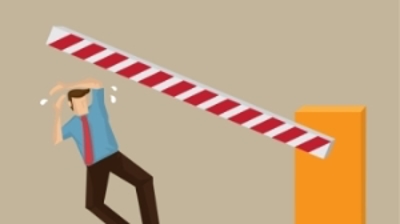Manual Door Closers

Do you have an open and shut case?
By Michael Panish, Expert Witness
Download PDF of this article here
During the past several years I have been contacted many times regarding door injury claims related to manual door closers. In response to numerous inquires asking if I have published any manual door closer articles similar to the primers I have done on automatic pedestrian doors, I am offering this article for general information to assist attorneys in determining potential issues relating to manual door closer mechanisms.
Manual door closers are ubiquitous. We take advantage of their service on a daily basis without usually noticing that they are in place or that they are doing their job correctly. It is when something is seriously wrong with these closers that they become blatantly noticeable and potentially dangerous.
Manual door closers can be as simple as a spring on an old screen door, a cannon ball weight on an antique house gate, or as sophisticated as a modern day hold open device electronically integrated with a smoke or heat detector connected to a centrally monitored alarm system. This article will not discuss specific brands, manufacturers or proprietary construction aspects of these closers, instead it will discuss the most common reasons that manual door closers can create injury claims. This general discussion is meant to deal with door or frame surface mounted door closers. While concealed and center pivot door closers are common in some applications, the most prevalent and common cause of serious personal injuries pertaining to manual door closers primarily relate to surface mounted closers. No discussion of building requirements, code compliance, or ADA parameters pertaining to door closers will be addressed in this article.
How Do They Work?
In general terms, a manual door closer is designed to assist a person using a doorway allowing them to smoothly and effectively open and shut a door without the need to physically return the door to the framed opening themselves. When properly adjusted, there will be a slight "back-pressure", giving the user some feedback as to the weight of the door, followed by a smooth transition as the door glides easily open in front of the user. Upon reaching the maximum set opening of the door, the closer takes full control dampening the opening forces, quietly and gently closing the door until the door is back in the frame, latched and ready for the next user.
Does Cost Affect Their Performance?
There are many price ranges and quality levels of door closers currently available on the market. In most major commercial installations there is a tendency to standardize the door closers throughout the facility. Hotels, hospitals, and shopping malls typically use a heavy duty type of closer that when properly installed and adjusted should provide many years of trouble free service to the user. Maintaining all door closers for proper function and control is essential as with all mechanical devices. In apartment and office buildings budgetary constraints sometimes lead to the decision to use a mid range or lower priced closer. Sometimes a foreign made lower quality "look-alike" closer is substituted for a domestic made, quality product leading to premature failure of the closer mechanism and/or erratic and inconsistent operation.
Choosing Your Door Closer
Many architects and designers do not have the foresight or knowledge to realize that the door closer is one of the most highly used pieces of equipment in any building, and they often make the wrong decision to use lower quality products in an effort to mistakenly and inappropriately save on building material costs. This choice of a lower-cost closer, combined with poor quality hinges, cheap door locks and other low quality installed hardware, affects the functions of the lower end door closers. The combination of all of the lower priced components can multiply the potential for premature failure of any door system. All door components installed on a door, in conjunction with the door frame work as a team, and require proper maintenance and periodic inspections to assure safe and effective operation. The choice to use the best quality hardware does not always ensure a "bullet-proof" doorway, but along with proper maintenance and adjustment, the higher priced quality hardware is money well spent over the long run. In general, the higher the quality of the individual components, the easier the long term maintenance.
Why Can Door Closers Cause Injuries?
Based on my experience as a door and hardware contractor and forensic expert for doors and door components, here are the three most common reasons that injuries occur due to door closer malfunctions. While this is not an exhaustive list, and there are always new and unique situations, these issues happen repeatedly and tend to set a trend for how injuries develop. (1) Door closers are misused, (2) Door closers are misunderstood, (3) Door closers are improperly installed.
Misuse
There are a variety of reasons that a facility uses the wrong hardware. Generally, the selection of the type, brand, style, and capacity are specified improperly. Cost constraints are often a key reason. In some cases this is due to the poor direction and discretion of designers or architects. Many times hardware sales representatives solicit offices of architects and designers pitching and promoting products that are not always the correct choice for a specific application. These sales representatives can convince a designer that their products are universally applicable, and even though there are often significant problems with these installed products, architects are very seldom alerted. It is not until the design firm is included in litigation for an injury that they become concerned with their methods of choice. Many times architects are protected by a time warranty parameter that is used in an attempt to limit their contractual responsibility. Most architects or designers have never worked in the field of door and hardware sales, nor have they ever participated in product installation, usage, and long term application. These architects are no more qualified to specify a door closer product than they would be to work as a surgeon, just because they designed a medical suite space. Sales representatives often provide financial incentives, promises of future project leads, and assurance that their promoted product is as good as the more expensive hardware. Normally, these promises come with a potential for a reduced cost, rebate, or perceived savings to the end user. Sometimes, foreign made door closers are substituted for a higher quality domestic door closer without the knowledge of the end user. The products may appear similar, however in reality the promises and warranties made by the sales representative may not be realized. Sales representatives tend to come and go, and long before many projects are completed the sales rep has moved on, leaving the end user ultimately responsible for the problems that will arise. Incorrect, undersized or oversized closers often get installed leading to problematic performance at the direction of the uninformed or ill-informed "design professionals. Lower product costs do not usually equal higher performance in the long run!
Misunderstanding
Many times, the primary cause of door closer failures is the direct result of improperly trained or unsupervised maintenance personnel. Most domestic door closers are evaluated, tested and approved for sale prior to being brought to the market. They have gone through stringent testing, have been rated for longevity, usage in fire, and are warranted for a specified lifetime. Many manufacturers will offer replacement of products when periodic maintenance has been performed by trained individuals. Often, the higher quality door closer bodies have a "built date" stamped onto the closer body. The more reputable manufacturers rely upon this date to establish the lifetime of the closer body. This is based on presumed cycles of usage, correct adjustment, and proper appropriate maintenance. Appropriate maintenance is necessary to assure the safe and proper functioning of the door closer mechanism. Many times, individuals charged with maintaining a facility have little or no training with regard to door hardware, especially door closers. These workers often make random improper adjustments, create and compound existing problems due to partial or complete lack of knowledge and are sometimes the genesis of the ultimate failure of a door closer, leading to serious bodily injury. In many facilities, these "maintenance" workers are usually called upon to fix everything from a leaking toilet to replacing a burned out light bulb. Facility employed maintenance workers are often paid low wages and are directed by management to attempt to correct deficiencies when doors do not function correctly. In an effort to save costs, trained hardware professionals are rarely called in. Many times, the door closers have been so badly damaged by these inappropriate and random adjustments that the entire door closer must be replaced. Normally, replacing or rebuilding the door closer because of improper maintenance far outweighs the expense of a periodic maintenance program performed by professionals. There is no substitute for professional evaluation and maintenance when it comes to assuring the safe, code-compliant, and proper operation of all doors and door hardware.
Proper Installation of Door Closers
Many modern door closers have universal and unhanded application potentials. This means that depending upon the desired location of the closer body, there are generally a variety of possible mounting options. One manufacturer offers a closer body that can be positioned and safely operate in at least six different configurations. The door closer body can be installed on the door itself, or installed on the frame of the doorway. The closer can be used on either the push or the pull side of the doorway. The closer body can be installed for "normal regular arm" usage, "parallel arm" usage, or the reverse of both orientations. The closer can be adjusted to open the door from 90 degrees to 180 degrees. In some applications, the door can be adjusted to open as much as 270 degrees all relative to the closed state of the doorway. In other words, universal installation makes a closer of this type flexible and beneficial to a commercial door hardware installer. For some installers this could be seen as the "one size fits all" closer solution, is generally the most expensive, and is the standard door closer desired by most door and door hardware professionals. This type of door closer is normally unavailable to the average consumer and is sold through professional hardware supply companies. On the opposite end of the price and flexibility spectrum are the single use, single-handed door closers. This means that they are only able to perform one function, and must be ordered either to apply to a right handed door or a left handed door. These door closers are cheap, have a limited life, and are not expected to operate in heavy commercial usage. These door closers are the type that are available to the average consumer and are sold in the local home improvement or big-box type of hardware supply stores.
In every door closer application, the one basic essential requirement is that the door closer body and door closer arm be properly and securely attached to the doorway components. A door closer body and arm operate the opening and closing actions of the door that they are mounted to, exerting forces that are controlled by a few different methods. Some closers operate using spring tensions while others operate using air pistons. The most elaborate and sophisticated closers function using both spring tension and hydraulic cylinders. Gearing designed like a "rack and pinion" system are employed in some devices. Cycling of these devices creates movement of pistons that push hydraulic fluid into various chambers. In conjunction with this fluid transfer, springs offer additional assistance in movement of the various portions of the cycle of the arc swing of the door. Spring tensions are set based upon door size and weight. Specific engineered locations for placement of the closer bodies and arms have been determined by the manufacturers to allow certain features to operate correctly, consistently and safely. It is mandatory that all manufacturers' instructions for positioning the door closer body be followed closely, and with care. Proper positioning of the closer arm is critical as well. The entire closer mechanism depends on the interaction of all of its individual components. The main closer body, the arm, attachment brackets and points of attachment need to work in harmony to assure safe and dependable operation. It is essential that proper products be used to attach the door closer and arm to the door and frame. These points of attachment (screws and bolts) may be regulated by fire codes, life safety codes or other ANSI (American National Standards Institute) standards. Appropriate screws, bolts and other needed hardware are engineered for usage with the closer bodies and arms by the closer manufacturers, and need to be maintained just as the operable portion of the closers need adjustment and service periodically.
Forensic Analysis of a Failed Door Closer
I have been retained as a forensic expert for many law suits pertaining to serious injuries resulting from malfunctioning or missing door closers. Often times, the door closer was improperly installed or removed due to malfunction. In some instances, the usage of non-rated hardware, such as inappropriate bolts or screws, lead to the closer body or arm simply shearing off the bolts or screws during normal operation. There are many unseen aspects engineered into a well designed product that take into consideration conditions and working forces that the average consumer or user of these products are never aware of. Most high quality door closers are sold with a package of screws, bolts and washers engineered to assure safe installation of the product. The bolt and screw sets have been designed through calculated engineering to safely handle the load requirements of the closer action, assuring a safe transfer of operating forces to the door and frame points of attachment. As mentioned above, foreign made "look-alike" products are not always built using the same quality components, manufacturing techniques, or hardware that a well made domestic product employs. In my observations, more failures of the attachment screws and fasteners have occurred from foreign products than domestic products. The foreign products are not always tested to assure the quality of attachment components. The milling and casting processes of these foreign door closers are not always up to the higher standards of domestic products. During forensic analysis debris and other contaminants related to the manufacturing process have been observed in the chambers of some foreign closers that have malfunctioned.
Another critical aspect of installation relates to the competency of the installer. It is required that most screws and bolts have holes pre-drilled and are tapped using the appropriate size and pitch tap to assure that the bolts used for holding both the closer and the arm be properly anchored to the door and frame. Some manufacturers have furnished self drilling screws for this application, but it has also been my experience that the self tapping screws do not work as well as a manually tapped thread for long term attachment. Door closers can have significant weight, and therefore, it is essential that they are properly installed. I have seen several cases where the closer simply fell off of the door, striking a user in the head, shoulders, and arms. While a good quality closer body usually weighs around five pounds, some closers weigh as much as fifteen to twenty pounds depending on their function, and are often installed eight to ten feet off of the ground. When an average user is struck on the head, that fall can equal forces far in excess of the actual weight of the closer alone. Remember that basic physics says force is equal to mass times acceleration. Falling door closers can lead to serious significant injuries. In at least one case where I was retained as the expert witness, a fallen closer lead to the death of an elderly individual.
Proper attachment of the closer body and arm also play a key role in determining closer related injuries. The actual sub surface point of attachment that the closer and arm must mount to are sometimes undersized or do not have the structural integrity that is required to tolerate the forces exerted by the door closer. While it may not seem important to the average user, a lack of firm and positive attachment of the door closer body and arm often lead to jerky or staccato operation of a door. The closer body and arm act as a sort of leveraging force to motivate or move the door through the arc cycle of the door swing. When door closer components are loosely attached, there is the possibility that opposite forces imparted during portions of the closer cycle can create adverse reactions leading to a "kick back", or unexpected movement of the door. This "kick back" or unexpected movement has caused several injuries due to the "surprise" reaction that normally takes place when a person is confronted with an abnormal expectation. As I stated above in this article, most people do not even notice the door closer when using a properly functioning door. Surprise reactions from fighting a malfunctioning door closer often create overcompensation of bodily movements. Those reactions have lead to muscle and tendon tears, spinal damage and blunt force trauma injuries in several cases I have been involved with. Improperly attached, poorly adjusted or defective closers have also been responsible for significant injuries as a result of violent unexpected movements that have caused the door to close so forcefully that the user was unable to clear the doorway opening prior to being sliced by a rough edge of the affected door.
Forensic Analysis of a Defective Door Closer
Recreating an event in a lab is often difficult if not impossible for the forensic analysis of the failure modality of a door closer. In order to effectively recreate a problem that may have occurred resulting in an injury there are many steps that need to be included and evaluated. Among the most significant aspects of recreating an alleged problem in a laboratory type setting is the need to acquire the correct product. In many cases, you are fortunate to have been able to remove, examine and destructively evaluate the condition of the closer involved in an injury case. However, there are and have been cases that I have been involved with where the evidence (door closer, door, frame, hinges, door seals, other hardware) were removed, destroyed or damaged beyond use. This spoliation of evidence is sometimes intentional. Involved parties conveniently lose hardware, claim that nothing has been changed, all the while being fully aware that some change or repair to the closer of issue will interrupt the legitimate discovery process. Sometimes, a surveillance video clip made at the time of the incident disappears along with the hardware evidence. In direct contrast to the issue of spoliation of evidence, I have been flown across the country to evaluate a door closer related injury just hours before a building was to be torn down. In that case, I was able to photograph the scene, preserve and record all pertinent data and retrieve hardware. This was done within a twenty four hour period of my retention to assure that the evidence was not lost or spoiled.
One of the most important aspects of destructive testing of a door closer is that the alleged defective closer be made available for inspection. It is critical that the "actual subject door closer" be tested rather than a far removed similar product. If for some reason the actual closer involved in an incident is not recoverable for testing, it would be grossly inappropriate and inconclusive to attempt to examine a door closer of a similar type. The only possible exception to this statement is if an exact representative product, manufactured at the same time, same plant, same assembly line and same assembly crew could be located. The chance of meeting these qualifications seems very slim and remote. The reason that an exact, although partial side by side comparison could be made of this product in the above scenario is that it would be closely, if not identically representative of the conditions and manufacturing that could have occurred with the subject closer product. As most unused closers are not found to be defective, it is still possible that this side by side comparison would not be representative of the conditions or "lifetime experiences" endured by the subject door closer. In summary, if the actual subject door closer is not available, any and all testing made using a presumed example should not be considered indisputably representative or completely valid.
Inspection of a defective or malfunctioning door closer should include a thorough battery of tests. Included among these tests should be function swing checks, force assessment, component analysis and product manufacturing residuals. There are many specific and highly detailed methods for analyzing a defective product or component of that product that will not be discussed in this article. Protocol for evaluating a defective closer, along with procedures to preserve the evidence is mandatory to achieve conclusive and definitive results.
Positive Identification of a Door Closer
Remember the old adage "You can't judge a book by its cover." Or, in this case a closer by its components. Outward appearances of a closer body cover may not be indicative of what product is in place beneath the cover of the closer. You cannot be positive that the cover attached to the defective closer body is original to that closer. Does the cover of the closer match the make and manufacture period of the closer body and arm of the closer? You may not be able to tell.
I was once involved as expert witness in a case where an incorrect metal cover had been substituted for the original plastic cover that had broken. The aluminum cover was forced into place on a closer body. This created interference with the correct operation of the arm and lead to the closer cover becoming a sharp hazard. A serious arm injury occurred as a result of incompetent maintenance.
There are many closer arms that are interchangeable (possible to attach to the closer body). That does not mean it is appropriate for a particular closer body, and interchangeability can also lead to defective or inappropriate operation of a door closer mechanism. You cannot always positively identify the make and manufacturer of a closer body based on a visible arm design. Styles of arm designs have been copied including maker's marks and logos by foreign closer manufacturers.
Similarly, many closer covers are "usable" on closer bodies that are not manufactured by the same company as the cover. It is virtually impossible to assess the make and manufacturer of a closer body by the cover. "Never judge a book by its' cover." Foreign "knock-off" closer manufacturers sometimes have identical designs to domestic products, yet the closer quality is sometimes inferior and unreliable. Domestic manufacturers often have parts that will interchange with other manufacturer components and allow for covers to be placed on a variety of closer bodies made by other companies. The only completely accurate way to identify the closer body and manufacturer is to have the actual subject closer available for forensic analysis.
There are many more tests that can be done to a door closer. The above information gives you basic and general beginnings of a scientific and controlled evaluation of a defective or allegedly defective piece of equipment. In all cases of forensic analysis, it is critical to fully record, document and photograph your methods, observations and results. In this way it is possible to positively corroborate your findings at a later date. Realize that this article is meant as a cursory overview of how to assess a door closer injury. It is meant as a very basic guide to show how different factors contribute to a door closer injury. Many pertinent steps and methods of detailed analysis of a defective door closer have not been discussed in this article.
Door closer injuries are frequent. I have been involved as an expert witness in dozens of door closer cases throughout the United States. I have been retained as an expert witness by both plaintiff and defense for door closer injury claims. My door and hardware business, "Door and Hardware Systems" specializes in providing preventative maintenance programs for large commercial venues, hospitals and hotels. We design, develop and provide services to assure life safety, ADA code compliance and door inventory control. My forensic analysis services and courtroom display models have been used in many cases recreating and demonstrating the conditions leading to serious personal injury and have helped resolve claims to end disputes.
Mike Panish is a forensic expert witness and consultant in the construction industry. One of his primary areas of expertise pertains to doors and automatic door cases. He has over 35 years of hands on experience dealing with commercial, multi residential, hotel, hospital, lab and other locations where specialty door systems are needed. He has written several articles on the subject of door related claims and maintenance issues related to door and automatic door systems. He is licensed as a door and hardware contractor in the State of California. He has been involved in door cases across the United States. He has been used as a consultant and has been retained and designated as expert in many types of door injury related claims for both the plaintiff and defense. Mike is able to quickly ascertain the facts, explain the critical information pertaining to your case and can assist you in developing your case from discovery through trial. He has offices in California, New Hampshire and Massachusetts. He is available for nationwide, inspection, consulting, expert analysis, and testimony.
Michael Panish can be reached at (888) 902-4272 or Expert@ConstructionWitness.com.



